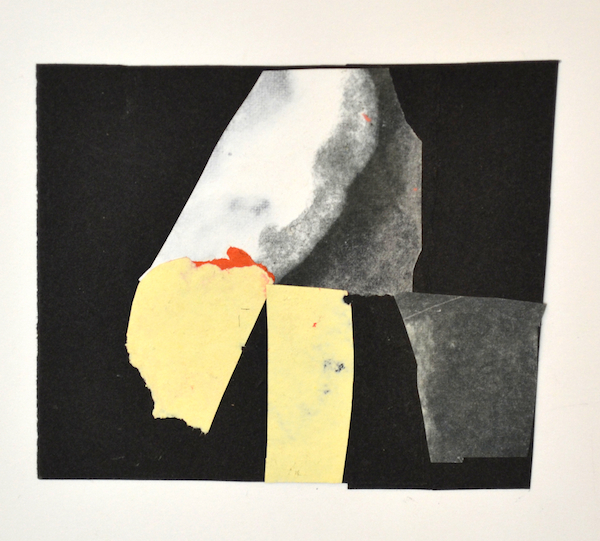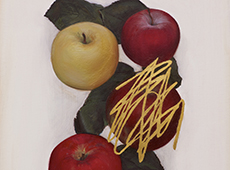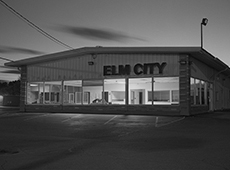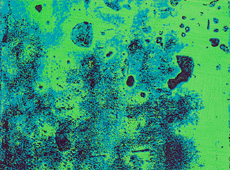“Once a book is written, I feel that I have said what I had to say… So I decide that it might be best for me to do something else. Lately, this “something else” has been the making of collages…which now seems to have become a fixed daily activity, and one that I have no desire to relinquish. So, I don’t know if I’ll write more poems. It seems more likely that I shall write more prose…and that I’ll write more essays about painting.”
Mark Strand: Collages
5 September – 5 October ’13
Lori Bookstein Fine Art
138 10th Ave New York, NY 10011
212.750.0949

Mark Strand, “Madrid 2012.” 2012.
Courtesy the artist and Lori Bookstein Fine Art, New York.
The poet Mark Strand‘s long writing career is, by now, pretty much on the books history. There’s the teaching (and plenty of it: Columbia, Harvard, Princeton, Yale and University of Chicago make up the shortlist); the books (thirty-six, at last count, ranging over poetry, criticism, fiction, translation and three very wonderful children’s books); and the awards (two Fulbrights, a MacArthur, the Bobbitt, the Bollingen, a Pulitzer, the Wallace Stevens Award, the American Academy’s Gold Medal). But before he sat down to learn about writing, Mr Strand studied painting at Yale. His teachers were Josef Albers and Bernard Chaet. Page through Albers’s Interaction of Color and you’ll see some of Strand’s student work there. Now, at 79, Mark Strand says he’s done with poetry and is returning to art full-time. Here’s Strand:
“Once a book is written, I feel that I have said what I had to say… So I decide that it might be best for me to do something else. Lately, this “something else” has been the making of collages…which now seems to have become a fixed daily activity, and one that I have no desire to relinquish. So, I don’t know if I’ll write more poems. It seems more likely that I shall write more prose…and that I’ll write more essays about painting.”
This isn’t the first time Strand’s quit writing poems. Just after the publication of Selected Poems (Atheneum, 1980), he gave up writing poetry for nearly ten years. “I didn’t like what I was writing,” Strand told the poet Jonathan Aaron later in 1995. “I didn’t believe in my autobiographical poems.” Instead, he wrote and edited prose–including two volumes of art criticism, The Art of the Real (C. N. Potter, 1983) and a book on his friend, the painter William Bailey (Harry Abrams, 1987). He returned to poetry with The Continuous Life (Knopf, 1990) and a term as U. S. Poet Laureate. Since–and until just last year, with the publication of Almost Invisible (Knopf)–poetry’s regained the center of Strand’s career. But now there’s something steadfast about his quitting, and about his no-desire-to-relinquish collage, and it’s apparent in the new work itself.
*
The fifteen collages now on view at Lori Bookstein’s in Chelsea are doozies. At first, they seem to be all about surface and, given the materials involved, it makes sense that they should. Strand, working with master papermaker Sue Gosin, makes his own papers using a process that gives him near complete control over color (he mixes his own pigments which he adds to the pulp), thickness and opacity. He uses it all as medium, rather than as stock, making his collages more painting than assemblage. Again, Strand:
“I deliberately avoid the suggestion of content in them. I’m not rescuing bus tickets, train schedules, newspapers from the garbage and giving them a new life as a work of art. I am just making papers that I think will look good when I tear them up and put them next to other pieces of paper.”
And it’s this juxtaposition of materials, especially within the compact rectangle Strand prefers, that make things work out so well. Strand’s collages are small and rather intimate–the largest is about 6 by 8 inches–and, because they are, they encourage long looking. Once you spend some time with them, you’ll see that they’re mostly about space, about entering and staying awhile. Layering the paper, using its varying transparencies and deckled-edges, creates a startling sense of depth. It’s completely unexpected, especially from a kind of art that historically tended to privilege the quick and the cerebral over the meditative and the illusory. For Strand, collage is a purely visual experience, focused on pictorial space and painterly concerns. And, unlike his poems, they sidestep autobiography and cryptic personal content. At a time when the provisional, the uneasy, the uncertain and the mocking seem to be all art can come up with, Strand’s collages make me optimistic. They reconnect me to that part of art history we seem to have forgotten: the part that showed how materials–and materials only–can transcend and enliven when used well.
“...You forgot to enter postid in the gallery shortcode...
Images Courtesy the artist and Lori Bookstein Fine Art, New York.
* From The Untelling, ©1973 Mark Strand.
Subscribe to Tilted Arc
If you like this story, please consider subscribing. We are sticklers for privacy.
We will never sell or share your e-mail address.



